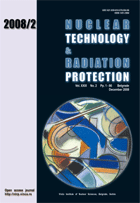
SOME QUESTIONS ON NUCLEAR SAFETY OF HEAVY-WATER POWER REACTOR OPERATING IN SELF-SUFFICIENT THORIUM CYCLE

Vol. XXIII, No. 2, Pp. 1-86
December 2008
UDC 621.039+614.876:504.06
ISSN 1451-3994
....Back to Contents
Pages: 22-27
Authors: Boris R. Bergelson, Alexander S. Gerasimov, Georgy V. Tikhomirov
Abstract
In this paper the comparative calculations of the void coefficient have been made for different types of channel reactors for the coolant density interval 0.8-0.01g/cm3. These results demonstrate the following. In heavy-water channel reactors, the replacement of D2O coolant by H2O, ensuring significant economic advantage, leads to the essential reducing of nuclear safety of an installation. The comparison of different reactors by the void coefficient demonstrates that at the dehydration of channels the reactivity increase is minimal for HWPR(Th), operating in the self-sufficient mode. The reduction of coolant density in channels in most cases is accompanied by the increase of power and temperatures of fuel assemblies. The calculations show that the reduction of reactivity due to Doppler effect can compensate the effect of dehydration of a channel. However, the result depends on the time dependency of heat-hydraulic processes, occurring in reactor channels in the specific accident. The result obtained in the paper confirms that nuclear safety of HWPR(Th) lies on the same level as nuclear safety of CANDU type reactors approved in practice.
Key words: thorium fuel cycle, CANDU reactor, nuclear safety
FULL PAPER IN PDF FORMAT (306 KB)
Last updated on September, 2010